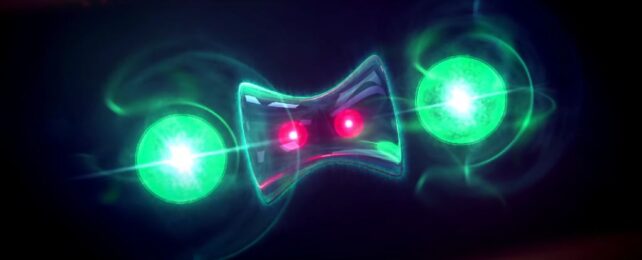 Still from an animation of a NIST quantum entanglement experiment conducted in 2013. (Yiheng Lin/NIST/YouTube)
Still from an animation of a NIST quantum entanglement experiment conducted in 2013. (Yiheng Lin/NIST/YouTube)
In the most massive test to date, physicists have probed a major paradox in quantum mechanics and found it still holds even for clouds of hundreds of atoms.
Using two entangled Bose-Einstein condensates, each consisting of 700 atoms, a team of physicists co-led by Paolo Colciaghi and Yifan Li of the University of Basel in Switzerland has shown that the Einstein-Podolsky-Rosen (EPR) paradox scales up.
The researchers say this has important implications for quantum metrology – the study of measuring things under quantum theory.
"Our results represent the first observation of the EPR paradox with spatially separated, massive many-particle systems," the researchers write in their paper.
"They show that the conflict between quantum mechanics and local realism does not disappear as the system size increases to more than a thousand massive particles."
Although we're pretty good at mathematically describing the Universe, our understanding of how things work is patchy at best.
One of the tools we use to close one of the gaps is quantum mechanics, a theory that arose in the early 20th century, championed by physicist Niels Bohr, for describing how atomic and subatomic matter behaves. In this tiny realm, classical physics breaks down; when the old rules no longer apply, new rules must be made.
But quantum mechanics isn't without its flaws, and in 1935, three famous physicists found a significant hole. Albert Einstein, Boris Podolsky, and Nathan Rosen described the famous Einstein-Podolsky-Rosen paradox.
Nothing can travel faster than light, right? But it gets a bit tricky with quantum entanglement, what Einstein referred to as "spooky action at a distance". This is where you correlate two (or more) particles so that their properties are linked; if one particle, for example, spins one way, the other spins the other way.
These particles retain this link even over large distances, and it's unclear how or why. Scientists do know that if you measure the properties of one particle, you can infer the properties of the other, even over that distance.
However, under quantum mechanics, the particle won't have those properties until you measure it (a quirk explored by the Schrödinger's cat thought experiment).
And, under quantum mechanics, if you know one property of a particle, such as its position, you can't know another, such as its momentum, with any certainty. This is the Heisenberg uncertainty principle.
The classical physics concept of local realism also states that for an object or energy to affect another, the two have to interact.
The EPR paradox, therefore, is complex. When you measure one particle in an entangled system, that measurement somehow influences the other particle, even though the measurement isn't taking place locally.
You also know more about the particles than is allowed under the Heisenberg uncertainty principle. And somehow, that influence happens instantaneously, defying the speed of light.
The EPR paradox, therefore, suggests that quantum mechanical theory is incomplete; it does not fully describe the reality of the Universe we live in. Physicists have mostly tested it on small entangled systems, consisting of just a pair of atoms or photons, often, in what is known as a Bell test (after its deviser, physicist John Stewart Bell).
So far, every Bell test conducted has found that the real world behaves in a way inconsistent with local realism. But just how deep does the paradox go?
Well, this is where we get to the Bose-Einstein condensates, a state of matter created by cooling a cloud of bosons to just a fraction above absolute zero. At such low temperatures, the atoms sink to their lowest possible energy state without stopping completely.
When they reach these low energies, the particles' quantum properties can no longer interfere with each other; they move close enough to each other to sort of overlap, resulting in a high-density cloud of atoms that behaves like one 'super atom' or matter wave.
Colciaghi, Li, and their physicist colleagues Philipp Treutlein and Tilman Zibold, also of the University of Basel, generated two Bose-Einstein condensates using two clouds, each consisting of 700 atoms of rubidium-87. They separated these condensates spatially by up to 100 micrometers and measured the properties.
They measured the quantum properties of the condensates known as pseudospins, independently choosing which value to measure for each cloud.
They found that the two condensates' properties seemed to be correlated in a way that could not be attributed to random chance, demonstrating the EPR paradox holding firm at a much larger scale than previous Bell tests.
The implications of the team's findings are largely relevant to future quantum research.
"Our experiment is particularly suited for quantum metrology applications. One can, for example, use one of the two systems as a small sensor to probe fields and forces with high spatial resolution and the other one as a reference to reduce the quantum noise of the first system," the researchers write in their paper.
"The demonstration of EPR entanglement in conjunction with the spatial separation and individual addressability of the involved systems is thus not only significant from a fundamental point of view but also provides the necessary ingredients to exploit EPR entanglement in many-particle systems as a resource."
Now go have a nice cup of tea and a sit-down. You've earned it.
The research has been published in Physical Review X.






0 Comments